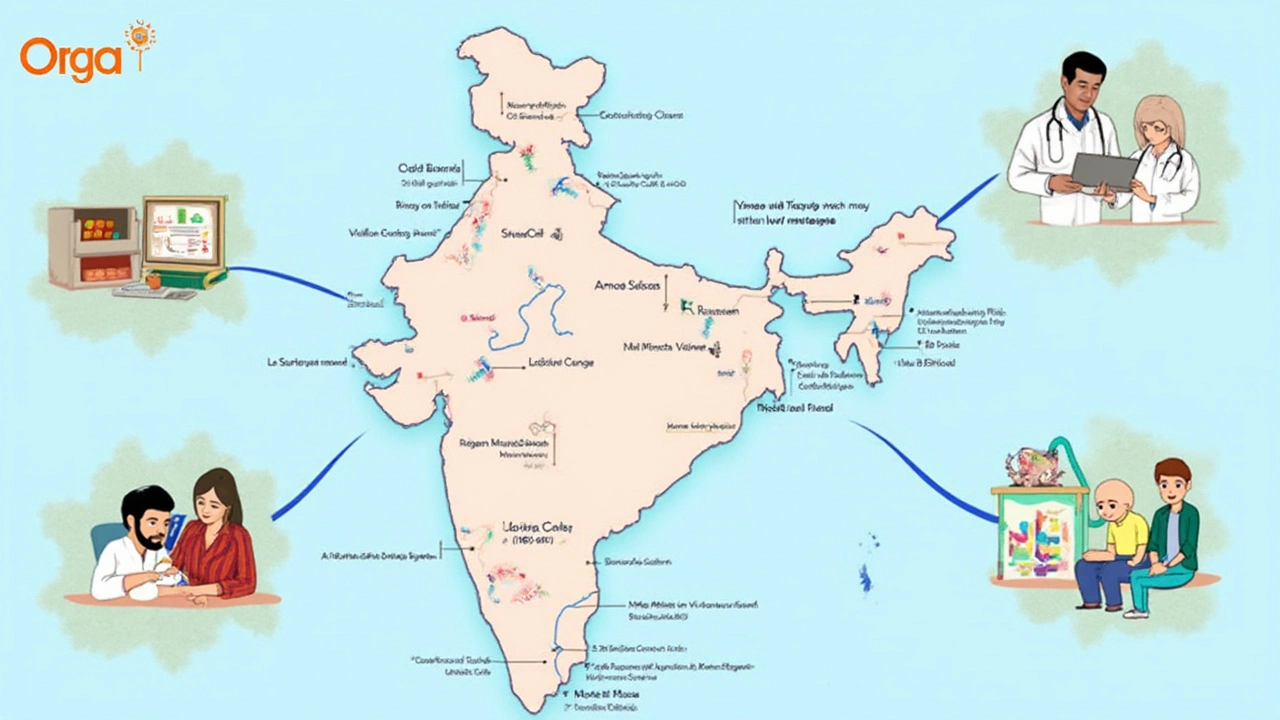If you’re sitting at your kitchen table with a notepad and calculator, trust me—you’re not alone. IVF costs in the U.S. feel like a riddle with too many moving parts. People ask, “Which state is cheapest for IVF?” hoping for one clear answer. The truth? It’s complicated, but it’s not a secret anymore.
On average, clinics in states like Georgia and Texas tend to offer lower IVF prices than places like California or New York. We’re talking starting prices as low as $7,000 per cycle in some Southern states, compared to $12,000 (or more) out West. But before you book that flight to Atlanta or Dallas, there’s way more to consider than just that eye-catching number on a clinic’s website.
IVF isn’t sold like a pair of shoes. The base price covers some things—like egg retrieval and fertilization—but doesn’t always include meds, genetic testing, embryo storage, or second attempts. These costs can double the bill fast. I know a couple who packed their bags for a so-called “cheap” clinic, only to get hit later with surprise fees.
So when tracking down the cheapest IVF state, start by asking clinics for an all-inclusive breakdown. Don’t just look at the base fee; you want the real, bottom-line cost for a full shot at pregnancy. And while numbers matter, the clinic’s success rates and reputation should sit right next to price on your priority list.
- How IVF Costs Vary by State
- Why Are Some States Cheaper Than Others?
- The Hidden Costs You Need to Know About
- Tips to Find Quality and Affordability Together
- Final Thoughts: Is Traveling for IVF Worth It?
How IVF Costs Vary by State
IVF price tags jump all over the map, depending on where you live or where you’re willing to travel. The difference can be pretty shocking—what might cost you $7,000 in Georgia could be over $15,000 in New York. On top of that, every clinic builds its fee structure a little differently. Some throw in all the extras, others tack them on later. This is why you can’t just compare one main number and call it a day.
Here’s a quick look at average base IVF costs (per cycle) in some states. Remember, these don’t always include medication or extra services:
| State | Average Base Cost Per IVF Cycle |
|---|---|
| Georgia | $7,000 - $9,000 |
| Texas | $7,500 - $10,500 |
| Illinois | $8,000 - $12,000 |
| California | $12,000 - $18,000 |
| New York | $13,000 - $16,000 |
Why do the numbers swing so much? Two things: local demand and how much big city living drives up a clinic’s overhead. States with more clinics fighting for patients often drop their prices, while places with just a handful can charge more. Also, some states have laws making insurance cover infertility treatments, especially in Massachusetts and Illinois. That can knock a big chunk off your bill—if your job’s plan actually covers it; not everyone’s does.
You don’t have to take my word for it. As Dr. Eve Feinberg, a reproductive endocrinologist, explains:
"Patients are surprised by how much the out-of-pocket cost can vary between clinics and states, even before you figure in add-on services or medications."
So if you’re on the hunt for the cheapest IVF state, it pays to dig into details. Don’t trust a ballpark figure off a website. Get every cost in writing, and always ask about payment plans or discounts. Just because a clinic posts a low price doesn’t mean there aren’t other fees hiding behind the curtain.
Why Are Some States Cheaper Than Others?
It might look random, but there are some clear reasons why you’ll find huge differences in IVF cost across the country. Local economics, state laws, and even the number of clinics fighting for business can either push prices down or send them through the roof.
First, the cost of living makes a big dent. Clinics in big cities with expensive rent—think San Francisco or New York—usually pass those costs on to their patients. On the flip side, states like Georgia or Arkansas have lower overhead, so prices drop.
Next up is state insurance rules. A bunch of states have IVF coverage laws, meaning some or all insurance plans must help pay for treatment. But here’s the catch: in states with no IVF mandate, clinics compete harder for private-pay patients, sometimes leading to price wars. In states with insurance mandates, clinics often stick to higher prices because insurers help foot the bill.
The competition factor is real, too. When you look at a place like Texas, there are a bunch of fertility clinics within driving distance, so they need to keep prices attractive. Compare that to smaller states with just one or two clinics, and there’s no real reason for them to lower rates.
Here’s a quick look at average base IVF costs by state, just to show you how big the gap can be:
| State | Average IVF Cost (1 cycle, base only) |
|---|---|
| Georgia | $7,000 |
| Texas | $7,500 |
| Illinois | $8,500 |
| California | $12,000 |
| New York | $13,000 |
If you’re thinking about going out-of-state for treatment, remember to add up travel and lodging. Also, don’t forget some clinics offer discount programs or package deals if you ask—especially in places with lots of competition.
If you want to compare clinics for affordability, take a close look at these factors:
- Does your state require insurance plans to cover IVF?
- How many clinics operate nearby, and do they post transparent pricing?
- What’s the cost of living (rent, salaries, staff) where the clinic is?
- Any hidden fees or extra charges?
Understanding these details is the real shortcut to finding the best deal for your IVF journey.

The Hidden Costs You Need to Know About
Let’s get real for a second. The sticker price on a clinic’s website doesn’t tell the whole story. The IVF cost you see on page one usually covers just the basics. What’s not obvious? All those extra charges that sneak up later on. Knowing what’s coming will save you a lot of stress (and a lot of money).
Here are some common hidden costs most clinics leave out of their headline price:
- Medications: These aren’t cheap. Most folks pay anywhere from $3,000 to $7,000 per cycle, on top of the base treatment fee. Costs go up if you need extra meds for stimulation or thaw cycles.
- Genetic Testing (PGT/PGS): Thinking about screening embryos for genetic issues? That can add $3,000 to $6,000 per cycle, depending on the test and how many embryos you screen.
- Embryo Freezing and Storage: Freezing embryos is handy, but storing them runs about $500–$1,200 per year. Some clinics charge an upfront storage fee, while others bill you yearly.
- Frozen Embryo Transfers (FET): Doing an FET down the road? Plan for another $3,000 to $5,000 per transfer, and that usually doesn’t include meds.
- Extra Testing and Procedures: Depending on your situation, you might get nickeled and dimed for blood work, ultrasounds, anesthesia, or surgical procedures. Every add-on drives the price up.
Want to see how this all stacks up? Here's what a typical breakdown might look like:
| Cost Item | Typical Range (per cycle) |
|---|---|
| Base IVF Cycle | $8,000 - $13,000 |
| Medications | $3,000 - $7,000 |
| Genetic Testing (PGT/PGS) | $3,000 - $6,000 |
| Embryo Freezing | $800 - $2,000 |
| Annual Storage Fees | $500 - $1,200 |
| Frozen Embryo Transfer | $3,000 - $5,000 |
Don’t forget travel costs, either. If you’re heading out of state to save, you’ve got airfare, hotels, meals, and even lost wages from time off work. For some, these costs outweigh the savings from «cheaper» clinics. Always ask clinics for a detailed estimate in writing, so you know exactly what you’re getting into. And if you can use insurance for anything—even meds—jump on it. Every dollar counts when you’re building a family.
Tips to Find Quality and Affordability Together
Don’t get hypnotized by the lowest price tag when searching for the IVF cost sweet spot. There’s a big difference between a budget clinic and a smart investment in your family’s future. Here’s how to be savvy with your money, but not compromise on the chances of building your family.
- Compare Clinic Success Rates: Check each clinic’s annual IVF success stats on the CDC’s official ART Report website. If a clinic doesn’t list honest numbers, that’s a red flag.
- Ask About the Real Price: Always ask clinics for a full cost breakdown, including meds, blood tests, ultrasounds, egg and embryo freezing, and extra lab services. Some states—like Arkansas—actually require insurance to cover some IVF, which can really help with the total bill.
- Look for Package Deals or Refund Programs: Many clinics now offer multisession packages or partial refunds if you don’t have a baby after a set number of cycles. These can ease the financial sting and offer more chances at success without piling up surprise costs.
- Check for Financial Help: Some places have grants, sliding scales, or discounts for teachers, military, or first responders. Even financing plans with reasonable interest rates can take the stress off.
- Consider Clinic Access: Cheap treatment across the country might not help if travel costs, time off work, and hotel bills stack up. Sometimes staying local saves more in the end.
Here’s a quick look at average base prices and some coverage differences in popular states:
| State | Average Base IVF Cost | Notable Facts |
|---|---|---|
| Texas | $7,500 | No state mandate for insurance coverage |
| Georgia | $7,200 | Some clinics offer bundle packages |
| California | $12,000 | Wide range of clinics with high success rates |
| Arkansas | $8,500 | Mandatory partial insurance coverage for IVF |
| New York | $13,000 | Mandated coverage, but stricter eligibility requirements |
Avoid clinics that won’t answer your questions or rush you into contracts. Online reviews and local support groups can be gold for honest feedback. The cheapest isn’t always the best, but with some legwork, you can usually find a clinic that balances price, reputation, and real results.

Final Thoughts: Is Traveling for IVF Worth It?
This is where things get real: is packing your bags and heading across state lines for “cheaper” IVF actually a good move? For some folks, saving a few thousand bucks on IVF cost sounds like a no-brainer, especially when the difference between, say, California and Georgia clinics is $5,000 or more. But before you buy extra suitcases, let’s unpack what really matters.
Here’s a quick look at average clinic fees by state. If you’re purely number crunching, it’s eye-opening:
| State | Typical Base IVF Cycle Cost |
|---|---|
| Georgia | $7,200 |
| Texas | $8,100 |
| Illinois | $9,500 |
| California | $12,000 |
| New York | $13,500 |
But flights, hotel bills, car rentals, and time off work add up—quick. A lot of couples shell out an extra $2,000 to $5,000 just on travel and temporary lodging. That “cheap” cycle doesn’t look quite as cheap after factoring in these extras, especially if you need multiple rounds or stay longer for procedures and checkups.
Quality shouldn’t take a back seat, either. Some clinics with lower costs might not have the latest equipment or highest success rates. Look up the CDC’s ART (Assisted Reproductive Technology) database, which posts every licensed clinic’s results. High success rates? That’s money well-spent, even if it’s not the rock-bottom deal.
- Ask every out-of-state clinic for their add-on and medication fees—no surprises wanted.
- Check if your insurance covers procedures outside your home state. Some plans balk at this.
- Factor in the stress and logistics of traveling for treatment, especially if a support system is important to you.
For a few people, traveling actually opens up new options and helps stretch every dollar. If you live in a state with pricey clinics or poor insurance laws, looking elsewhere honestly makes sense. Just be clear-eyed about the math and your comfort with being away from home while going through something so personal.
